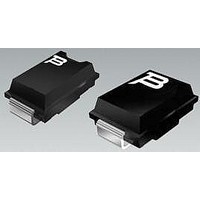TISP4360L3AJR-S Bourns Inc., TISP4360L3AJR-S Datasheet - Page 8

TISP4360L3AJR-S
Manufacturer Part Number
TISP4360L3AJR-S
Description
Sidacs
Manufacturer
Bourns Inc.
Datasheet
1.TISP4015L1BJR-S.pdf
(11 pages)
Specifications of TISP4360L3AJR-S
Mounting Style
SMD/SMT
Package / Case
DO-214AC
Lead Free Status / RoHS Status
Lead free / RoHS Compliant
Available stocks
Company
Part Number
Manufacturer
Quantity
Price
Company:
Part Number:
TISP4360L3AJR-S
Manufacturer:
BOURNS
Quantity:
240 000
The inductance of a transformer winding reduces considerably when the magnetic core material saturates. Saturation occurs when the
magnetizing current through the winding inductance exceeds a certain value. It should be noted that this is a different current to the
transformed current component from primary to secondary. The standard inductance-current relationship is:
where:
L
di
dt
E
Rearranging this equation and working large ∆ changes to saturation gives the useful circuit relationship of:
A transformer winding volt-second value for saturation gives the designer an idea of circuit operation under overvoltage conditions. The
volt-second value is not normally quoted, but most manufacturers should provide it on request. A 50 Vµs winding will support rectangular
voltage pulses of 50 V for 1 µs, 25 V for 2 µs, 1 V for 50 µs and so on. Once the transformer saturates, primary to secondary coupling will be
lost and the winding resistance, RW, shunts the overvoltage protector, Th1 - see Figure 9. This saturated condition is a concern for long
duration impulses and a.c. fault conditions because the current capability of the winding wire may be exceeded. For example, if the on-state
voltage of the protector is 1 V and the winding resistance is 0.2 Ω, the winding would bypass a current of 1/0.2 = 5 A, even though the
protector was in the low voltage condition.
Figure 10 shows a generic protection arrangement. Resistors R1 and R2, together with the overcurrent protection, prevent excessive winding
current flow under a.c. conditions. Normally these resistors would only be needed for special cases, e.g. some T1/E1 designs. Alternatively, a
split winding could be used with a single resistor connecting the windings. This resistor could be by-passed by a small capacitor to reduce
signal attenuation.
Overcurrent protection upstream from the overvoltage protector can be fuse, PTC or thick film resistor based. For very high frequency circuits,
fuse inductance due to spiral wound elements may need to be evaluated.
Normally, the working voltage value of the protector, V
equipment temperature range. This would give the lowest possible protection voltage, V
the transformer winding and increase the time to core saturation.
In high frequency circuits, there are two further considerations. Low voltage protectors have a higher capacitance than high voltage protectors.
Transformer Protection
TISP
= unsaturated inductance value in H
= winding voltage in V
= current change in A
= time period in s for current change di
®
TISP40xxL1AJ/BJ VLV Overvoltage Protectors
Device Voltage Selection
UNSATURATED
LINE
Th1
Figure 10. Transformer Winding Protection
PROTECT ION
CURRENT
L
Figure 9. Transformer Saturation
OVER-
T1
APPLICATIONS INFORMATION
E x
DRM
E
∆t
=
, would be chosen to be just greater than the peak signal amplitude over the
–
=
( (
L
Th1
L
di
---- -
dt
x
∆i
R1
R2
SATURATED
Customers should verify actual device performance in their specific applications.
T1
AI4XAN
(BO)
. This would minimize the peak voltage applied to
Th1
SIGNAL
RW
Specifications are subject to change without notice.
T1
AUGUST 1999 - REVISED JANUARY 2007
AI4XAO












